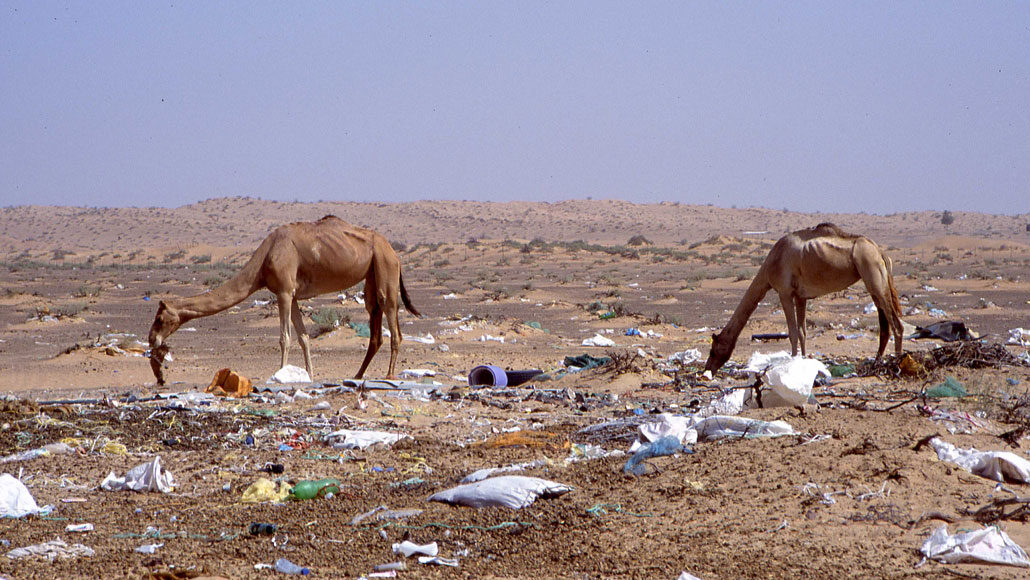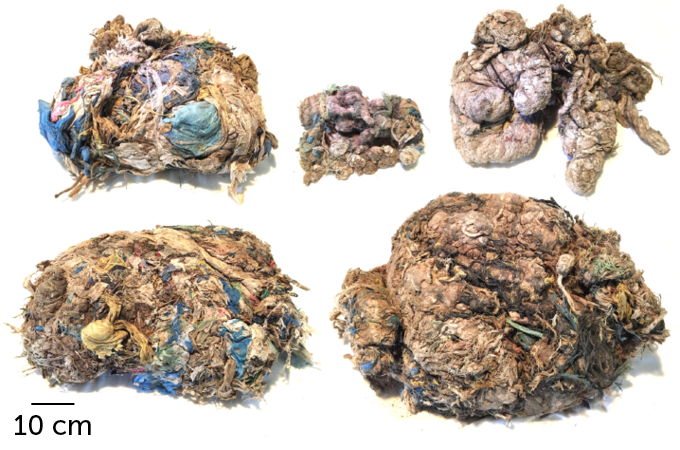Camels have been dying after mistaking plastic for food
Plastic bags and other trash in their stomachs form masses called polybezoars

These dromedary camels are foraging on desert trash, including plastic, outside Dubai, one of the United Arab Emirates. A new study suggests that plastic kills one in every 100 camels in the United Arab Emirates.
Ulrich Wernery
By Asher Jones
Marcus Eriksen was studying plastic pollution in the Arabian Gulf when he met camel expert Ulrich Wernery. “You want to see plastic?” Wernery asked him. “Come with me.” So they went deep into the desert. Before long, they spotted a camel skeleton.
As the two dug through sand and bones, Eriksen recalls, “We unearthed this mass of plastic.” Eriksen knows how pervasive plastic can be. He works for the 5 Gyres Institute in Santa Monica, Calif. It’s a research and education group that focuses on plastic pollution. But he was not prepared for what he saw here, in the desert. “I was just appalled,” he says. Inside the rib cage of a camel carcass was “a mass as big as a medium-sized suitcase, all plastic bags.”
When it comes to plastic waste, he notes, “We hear about marine mammals — sea lions, whales, turtles and seabirds — impacted.” But this is not just an ocean issue, he notes. “It’s a land issue, too. It’s everywhere.”
Wernery is a veterinary microbiologist. He works in a research lab in Dubai, part of the United Arab Emirates. Some 390,000 dromedary camels (Camelus dromedarius) live in the Emirates. Since 2008, Wernery’s team has examined 30,000 dead camels. Of thesse, 300 had guts packed with plastic.
As dromedaries roam the desert, they munch on plastic bags and other trash that drift into trees and pile up along roadsides. Explains Eriksen, to a camel “if it’s not sand, it’s food.”
Tightly packed masses of indigestible things can build up in the gut or people or animals. Scientists call them bezoars (BEE-zorz). Normally, these are made of vegetable fibers or hair (such as a cat’s hairball). Wernery and Eriksen call those they’ve found in the camels “polybezoars.” It points to their origin: plastic polymers.
A bezoar can be dangerous. As it fills the stomach, an animal may stop eating. No longer feeling hungry, they might starve to death. Plastic can also leach toxic chemicals. The polybezoars may even carry bacteria that can poison the one-humped camels, notes Wernery.

In a new study, Eriksen and Wernery report data suggesting that each year these polybezoars are killing off around 1 in every 100 of the Emirates’ culturally important dromedary camels. Of five camel bezoars analyzed for this study, the plastic content ranged from 3 to 64 kilograms (6.6 to 141 pounds).
Details appear in the February 2021 Journal of Arid Environments.
“If 1 percent mortality due to plastic is verified by future and more detailed studies, then plastic pollution will certainly represent a reason of concern for [camels],” says Luca Nizzetto. He’s an environmental scientist at the Norwegian Institute for Water Research in Oslo. Such studies are important, he says, because they “raise social awareness about this pollution.”
Banning plastic bags and single-use plastics is crucial for protecting camels and other wildlife, Eriksen says. “Plastic bags are escape artists. They blow out of garbage cans, out of landfills, out of trucks and out of people’s hands.” What’s more, he adds, “They travel for hundreds of miles.”







